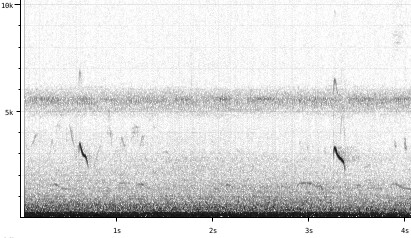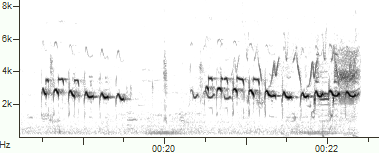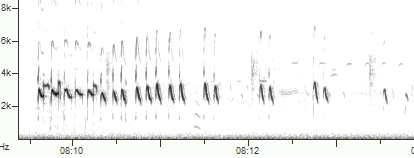Greater vs. Lesser Yellowlegs

Can you tell Greater and Lesser Yellowlegs apart by voice?
Can anybody?
A recent thread on the Xeno-Canto forum started me asking questions about how to identify yellowlegs by voice. Conventional wisdom says the two species can often be separated by their calls, at least with some experience. But as I was comparing the many online recordings, I came to an uncomfortable conclusion. Either an awfully high percentage of the recordings were misidentified, or my own identification criteria were wrong.
Today, I invite you to either share my confusion, or help me sort it out.
History of the problem
In the old days (i.e., the 20th century), identifying yellowlegs by voice was simpler. Back then, according to the field guides, all you had to do was count the notes:
| Field guide | Greater Yellowlegs | Lesser Yellowlegs |
| Peterson Western (1961) | A 3-note whistle, whew-whew-whew, or dear! dear! dear! | You or you-you (1 or 2 notes), less forceful than clear 3-syllabled whew-whew-whew of Greater Yellowlegs |
| Golden (1983) |
sharp 3- to 5-note whistle | soft 1- to 3-note whistle that lacks the loud ringing quality of the Greater’s |
| National Geographic (1999) |
loud, slightly descending series of 3 or more tew notes | higher, shorter than in Greater: 1 to 3 tew notes |
Although all three guides suggest differences in pitch and/or tone quality, most people took away a simple rule: three or more notes is a mark for Greater Yellowlegs, less than three notes is a mark for Lesser. Everybody understood that this was a rule of thumb and not a universal law, but still, it was a very popular mental shortcut.
Then Sibley came along, and started complicating matters:
| Greater Yellowlegs | Lesser Yellowlegs | |
| Sibley (2000) |
Flight call a loud ringing deew deew deew; typically three or four notes; higher than Lesser with strident overtones. In agitation an endlessly repeated single note tew, tew…. Feeding bird gives soft, single notes. Display song a melodious, rolling kleewee kleewee…. | Flight call of short whistles tip or too-too typically flatter and softer than Greater; usually only one or two notes. In agitation a repeated tiw, tiw…. Alarm a rising, trilled kleet. Threat a low, rolling trill. Display song a rapid, rolling towidyawid, towidyawid…; lower-pitched than flight call. |
Here the numbers are tempered with the words “typically” and “usually,” and pitch and quality get a little more attention. Most importantly, the yellowlegs are now presented as birds with large vocal repertoires — you have to be sure you’re listening to the “flight call” before you start counting.
So… how do you tell what you’re listening to?
The “classic” calls
Here’s a pair of recordings from the same location on the same date, by the same recordist, that fit all the classic descriptions of the two species’ “flight calls”:
 |
 |
Besides the number of notes, check out the huge difference in the shape of each note on the spectrogram. Lesser gives a pretty simple downslurred whistle, while Greater has a much more complex pattern. If you look carefully, you can see that each note of the Greater’s call contains an upward voice break. This means each note is 2-parted, the second part suddenly jumping to a much higher pitch. This happens so fast in each note that we still tend to hear the two parts as one, but the overall impression is very different from Lesser, more of a “klee-klee-klee” than a “pew-pew-pew.” The higher second part of each note is what Sibley refers to as the “strident overtones” of Greater.
The alarm series
Both yellowlegs give loud, incessant calls in series when they are upset, year-round. In Greater these notes are noticeably rougher than the typical “flight call,” due to a brief burry or grating sound in the middle of each note. In Lesser, the notes of the alarm call strongly resemble the notes of the “flight call,” but marginally higher. They are perfectly clear, without any trace of roughness:
Where it gets complicated
Here’s the bad news. Based on a set of positively-identified recordings (mostly those that also contain examples of each species’ diagnostic song, in the Macaulay Library collection), it’s pretty clear that
- the notes in Greater Yellowlegs “flight calls” don’t always break.
- the notes in Lesser Yellowlegs “flight calls” sometimes do.
- in both species, the number of notes in a “flight call” depends on the agitation level of the bird.
I don’t have any reason to believe these four recordings are misidentified. In fact, I was present for the recording of Andrew’s Dove Creek bird, and as I recall, it was seen well and its identification was uncontroversial. All these examples sound like they’ve got Lesser’s tone quality and Greater’s note pattern, and without visual clues, I’m not sure they’re identifiable, even on the spectrogram. Here’s another pair of examples:
 |
 |
| Greater Yellowlegs, from Macaulay Library 27042 (click to listen) | Lesser Yellowlegs, from Macaulay Library 26256 (click to listen; this vocalization is from the eighth minute) |
There are some differences in pitch and inflection here, especially towards the end, but the opening notes are nearly identical, and match my expectations for the “classic” Greater Yellowlegs tone quality.
A gallery of confusing yellowlegs
I’m relatively confident about the ID of all the recordings I’ve posted so far, but I’m not at all sure about the ones that follow. The only thing I’m sure of is that an awful lot of yellowlegs recordings thwart my original expectations of both species. Perhaps these next few recordings are all wrong, and yellowlegs identification isn’t as hard as I’m making it out to be! Perhaps they’re all or mostly right, and yellowlegs identification is very tricky indeed.
Any comments on the identification of these recordings, and yellowlegs vocal ID in general, would be greatly appreciated.
3 thoughts on “Greater vs. Lesser Yellowlegs”
Excellent post! I have found that Lessers will sometimes make 3-5 note calls, but in my experience the tone and cadence have always been different.
Hi Nathan,
First, I think this is a superb post, and I appreciate both the subject and well-organized content. I will be listening harder to Yellowlegs!
So my question: How confident are you in the ID of GRYE in the recording above (X-C43988 Mana Rice Fields, French Guiana)?
To my ear, it sounds higher pitched and a bit weaker…in the field I would probably call this a LEYE. I suppose that sort of variability is the point of your research on this subject. Have you personally observed this much overlap in Yellowlegs vocalizations?
Peter,
Like I said above, I don’t have any reason to believe that XC43988 is misidentified. But I’m willing to entertain the possibility.
The pitch of yellowlegs calls seems to me rather variable, and there is certainly a good degree of overlap between the species. I don’t necessarily think the French Guiana recording is outside the range of Greater Yellowlegs.
My own personal experience in the wild doesn’t count for much, because I’ve never paid a lot of attention to IDing yellowlegs by voice in the field, and all my audio recordings so far happen to be of Greaters. Now that the yellowlegs are appearing back in Colorado, I should go see what I can learn! If I can find the time…
Comments are closed.